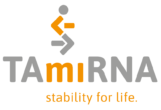microRNAs – function & biogenesis
microRNAs (miRNAs) are small non-coding RNAs that span between 18-24 nucleotides. MicroRNAs regulate gene expression on a post-transcriptional level through base-pairing with complementary sequences of the 3´untranslated region (UTR) of messenger RNAs (mRNA). This interaction results in gene silencing by cleavage of the mRNA strand or destabilization of the mRNA through shortening of its polyA tail or inhibiting the translation of the mRNA into proteins.
microRNAs were first identified in the organism C. elegans in the early 1990s. Currently, more than 2500 mature microRNAs have been identified in the human genome. A significant fraction appear to be highly conserved in other animals.
microRNA genes are transcribed by RNA polymerase II in the cell nucleus as long single-stranded RNAs (ssRNA) referred to as the “primary microRNA”, or “pri-miRNA”. The ssRNA transcript forms a hairpin loop structure, which signals for RNA nuclease cleavage by a nuclear protein complex called Drosha/Dgcr8. The resulting short hairpin RNA is termed “precursor-microRNA” or “pre-miRNA”. Pre-miRNAs are released into the cytoplasm by the nuclear export protein Exportin 5 and undergo cleavage by the enzyme Dicer into ~22 nucleotide-long mature microRNAs. After strand separation, the single-stranded mature microRNAs become incorporated into the microRNA induced silencing complex (miRISC). Through the RISC, the microRNA binds to the 3´UTR of mRNA molecules by direct base pairing. Binding of miRISC to a mRNA results in post-transcriptional gene silencing either through inhibition of mRNA translation or mRNA destabilization. The 5´UTR region of microRNAs is also known as seed region (nucleotides 1 through 8) and has the most crucial impact on targeting and function. MicroRNAs do not require perfect complementarity for target recognition and a single microRNA is capable of regulating up to hundred or more mRNA species.








